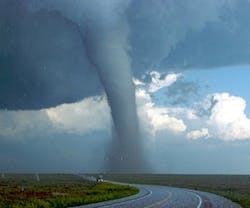Tornado Strength Increasing in Severity
Researchers have found a link between climate change and the strength and frequency of tornadoes hitting the U.S., according to a study in the journal Climate Dynamics. James Elsner, an expert in climate and weather trends, points out that while tornadoes are forming during fewer days, their density and strength are increasing.
In the past, researchers dismissed the impact of climate change on tornadoes because there was no distinct pattern in the number of tornado days per year. In 1971, there were 187 tornado days, but in 2013 there were only 79 days with tornadoes.
Despite increasing numbers, individual tornadoes have become far more destructive and virulent. Clusters of tornadoes within a 24-hour period are also becoming more common. For example, instead of one or two forming on a given day in an area, there might be three or four. The only silver lining is that the report shows the geographic areas most frequently impacted by tornadoes does not appear to be growing.
The U.S. experiences more tornadoes than any other country, and despite advances in technology and warning systems, they remain a hazard in storm-prone areas. The 2011 tornado season, for example, had nearly 1,700 storms and killed more than 550 people. In 2014, there have been 189 storms with a death toll of 43 so far, according to the NOAA/National Weather Service Storm Prediction Center.
"It's important for forecasters and the public to know this," Elsner says. "It's a matter of making sure the public is aware that if there is a higher risk of a storm, there may actually be multiple storms in a day."
Wondering if your building is secure enough for tornado season? Take a look at these tips to Protect Your Roof From Storm Damage.
